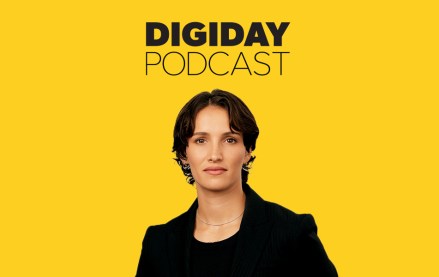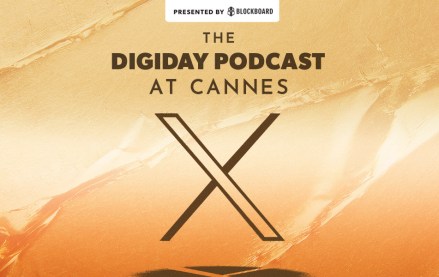How Group Black’s Kerel Cooper is trying to solve programmatic’s bias problem at the industry level

Subscribe: Apple Podcasts • Spotify
Following an on-stage conversation at the Digiday Programmatic Marketing Summit in December, Kerel Cooper, president of advertising at Group Black, joined Digiday once again on the latest episode of the Digiday Podcast to dive further into his continued efforts to shed light on the legacy programmatic media buying practices that often disadvantage Black-owned media companies.
Working with ad verification firm Double Verify, Group Black pulled together research that illustrates just how much ad inventory on Black-owned media companies is cut from media budgets when rudimentary tools like keyword blocklists and domain-level categorization are implemented in media buys.
Now, Cooper is working with his partners at DV to raise awareness of these findings to educate the buy-side as well as work with trade organizations to create standards for not eliminating large swaths of Black-owned media from programmatic spending.
In this conversation, Cooper talks about the results of the research with DV as well as how the deprecation of the third-party cookie is changing the way advertisers are up-ending their programmatic buying practices this year.
Below are highlights from the conversation, which have been lightly edited and condensed for clarity.
Programmatic has inherent disadvantages
When I first joined the company two years ago, one of the first initiatives that I undertook was launching our programmatic offering … We immediately saw that some of the buyers were having trouble scaling their buys across the publishers that we represent in the market. And as we start to dig into this, one of the things that rose really to the top as a challenge were some of these legacy buying practices.
[How] some of the programmatic algorithms work [is] these algorithms are looking for the largest pools of inventory at the cheapest price possible. And when you think about Black-owned media and diverse-owned media, some of these organizations are very small- or midsize, so they may not have the scale that a lot of other companies have. And if those domains are looped into a bigger, private marketplace, the algorithms are going to automatically move away from that inventory because it’s small.
As we started to dig into some of these challenges, my team was really tasked with going to each of the advertisers and trying to get them to maybe update how they were buying or coach them through or educate them on that. [But] going one-by-one to each advertiser is not a scalable way of going about it.
Breaking out of the silo
I immediately went to DoubleVerify directly, because a lot of the buyers that we were working with use DoubleVerify as their brand safety partner, and after having a few conversations with DoubleVerify and explaining to them the issues that we were having, they wanted to partner with us on research. They wanted to partner with us on educating buyers as well in the marketplace.
We are still in the process of figuring out how we bring buyers to the table, more supply partners to the table and industry trade organizations to come up with standards and best practices to help move the industry forward. It’s not scalable to go one-by-one to each advertiser. It’s not scalable for one publisher or one marketer or one trade organization to try to solve this in a siloed way. We really have to come together as an industry to put all the cards on the table and say, ‘OK, if we really want to make a change here, if we really want to make a sustainable impact of not only supporting Black-owned media, but again, reaching diverse audiences at scale, this has to be addressed at an industry-wide level.’
It’s not enough to build up revenue streams elsewhere. The money is still in programmatic
Look at all the data related to where spend is – programmatic spend continues to grow. Brands are continuing to put more and more dollars towards programmatic because it’s easy for them to buy that way. So I totally get it and I also understand from a publisher perspective, why they want to have direct-sold and why that’s a good alternative – it’s more control for the publisher, you have a better, more direct relationship [with advertisers and] all those things.
But the numbers don’t lie. And if the numbers say that programmatic is trending up and that’s where the dollars are going to go, we can’t ignore that from a supply-side perspective, right? We have to come to the table. And we have to bring the buy-side together at the table and say, ‘How can we solve this so that both sides are happy?’
More in Podcasts

How TikTok’s ‘The Secret Lives of Mormon Wives’ landed on Hulu, with Select Management Group’s Danielle Pistotnik
The talent manager and executive producer of “The Secret Lives of Mormon Wives” joined the Digiday Podcast to break down the process of the reality show finding a home on Hulu.

Digiday Podcast at Cannes: Former Bachelorette Rachel Lindsay makes the case for creators
Between panels and parties, creators are looking to get face time with ad execs, brand marketers and partners like Spotify. However, rather than coming to the Croisette to strike deals, they’re playing a long game.

Digiday Podcast at Cannes: From center stage to closed doors, inside X’s quiet Cannes strategy
Once a Cannes hotspot, Twitter Beach is no more. In this episode, we explore X’s quiet retreat from the Croisette—and why no one’s talking about the TikTok ban either.








